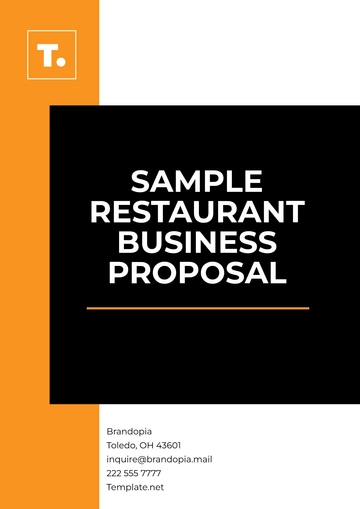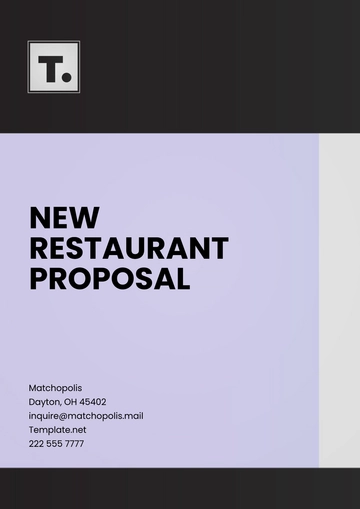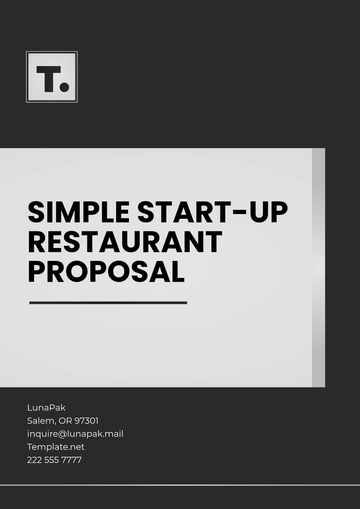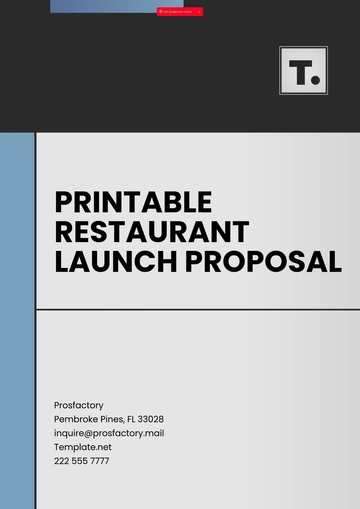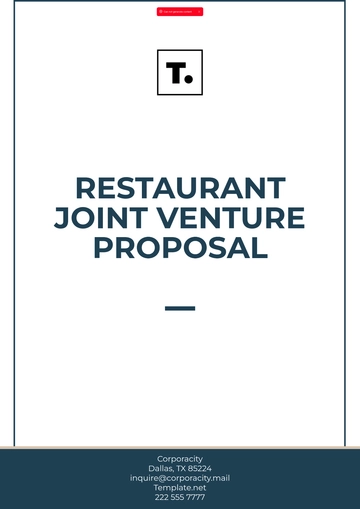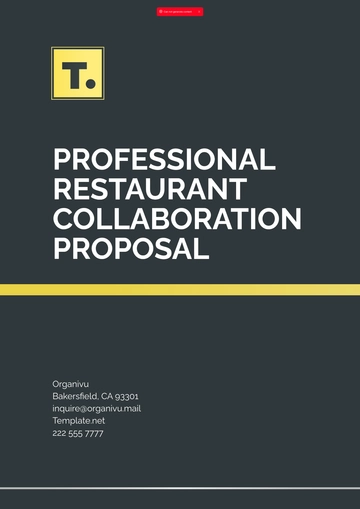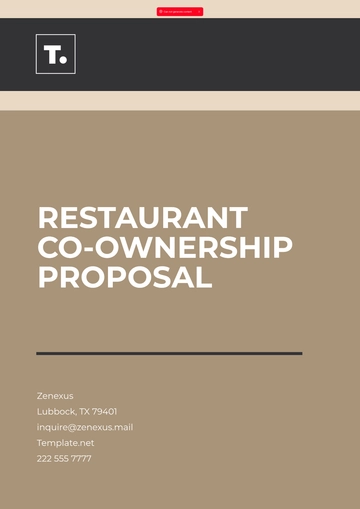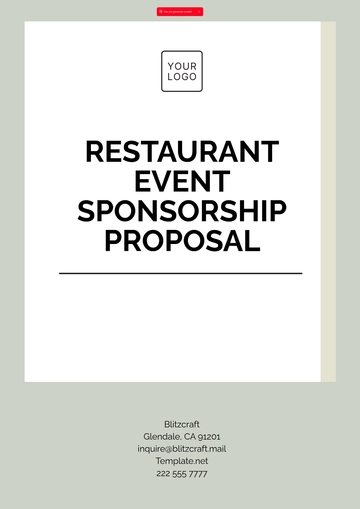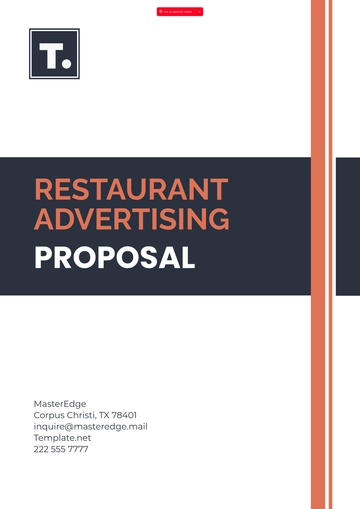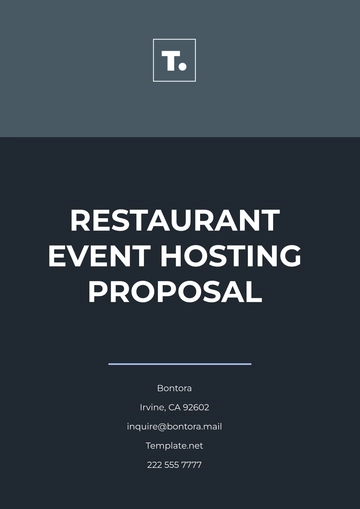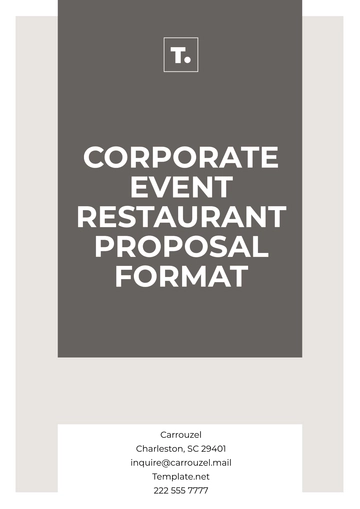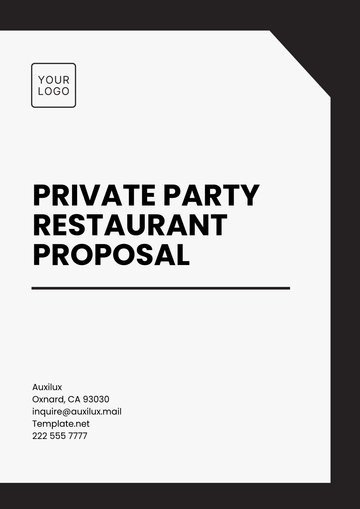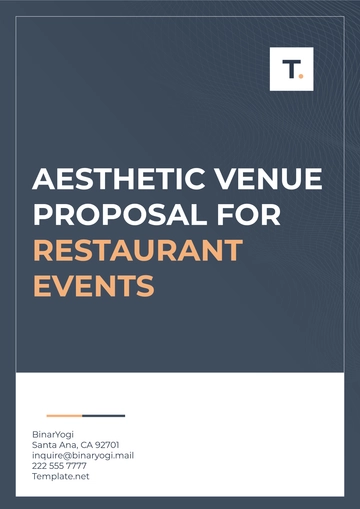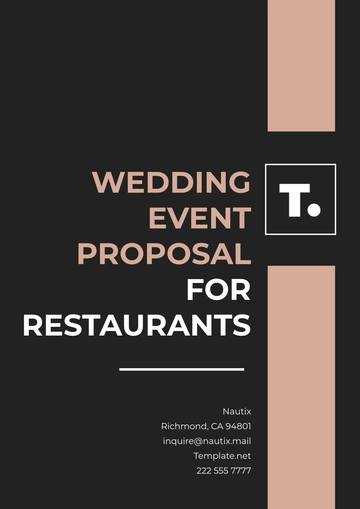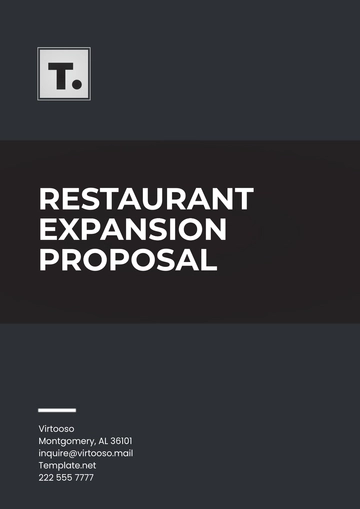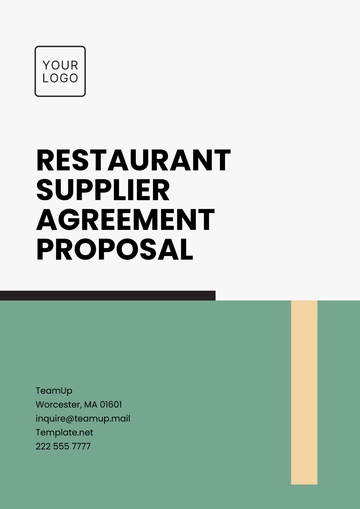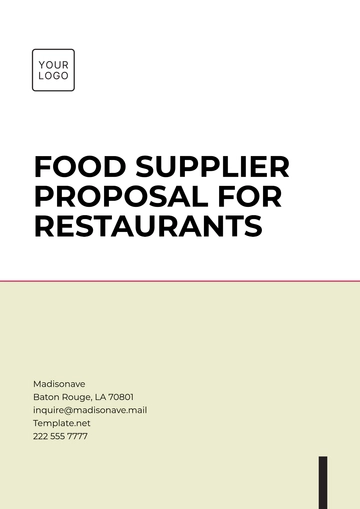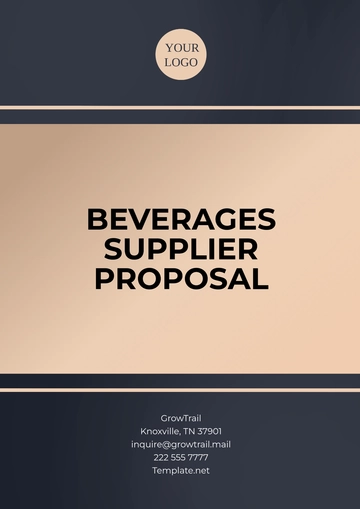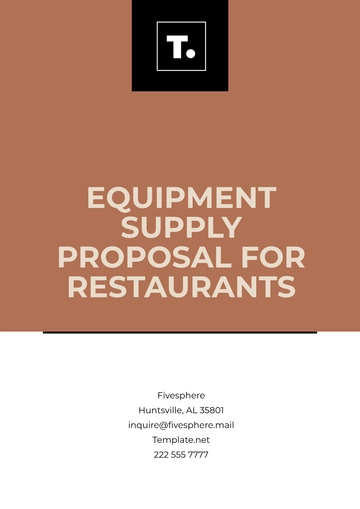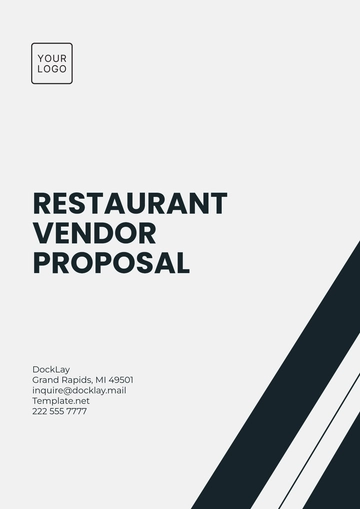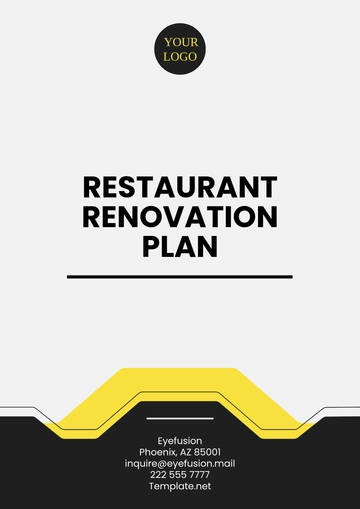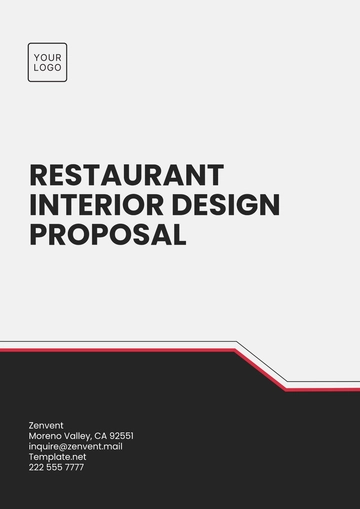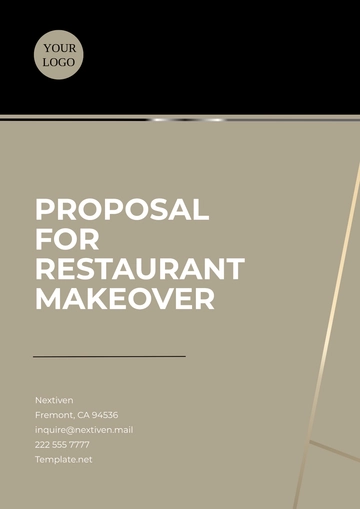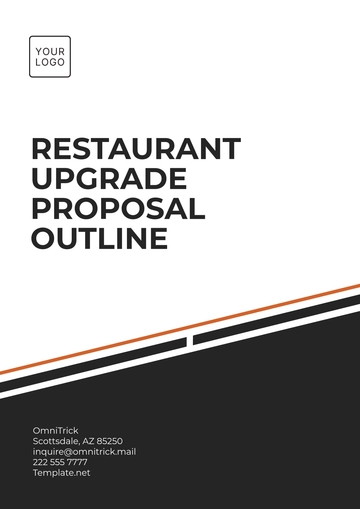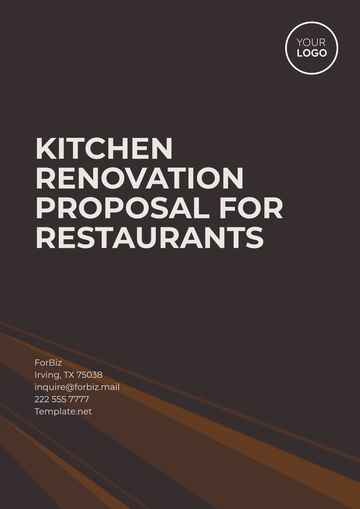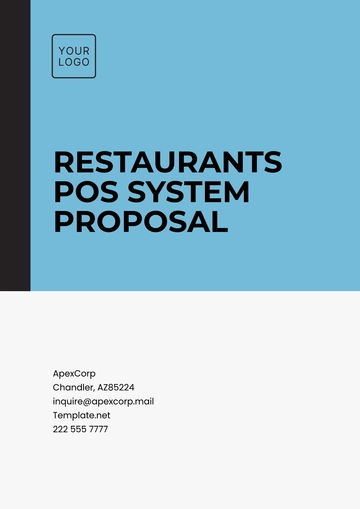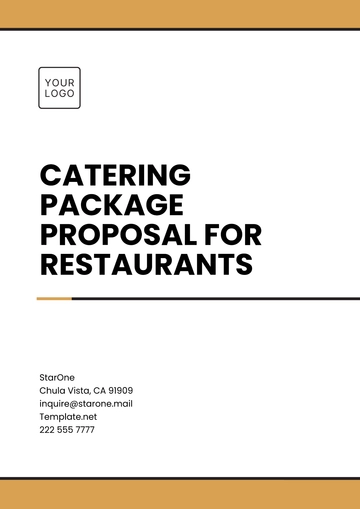Free Innovative Restaurant Business Proposal
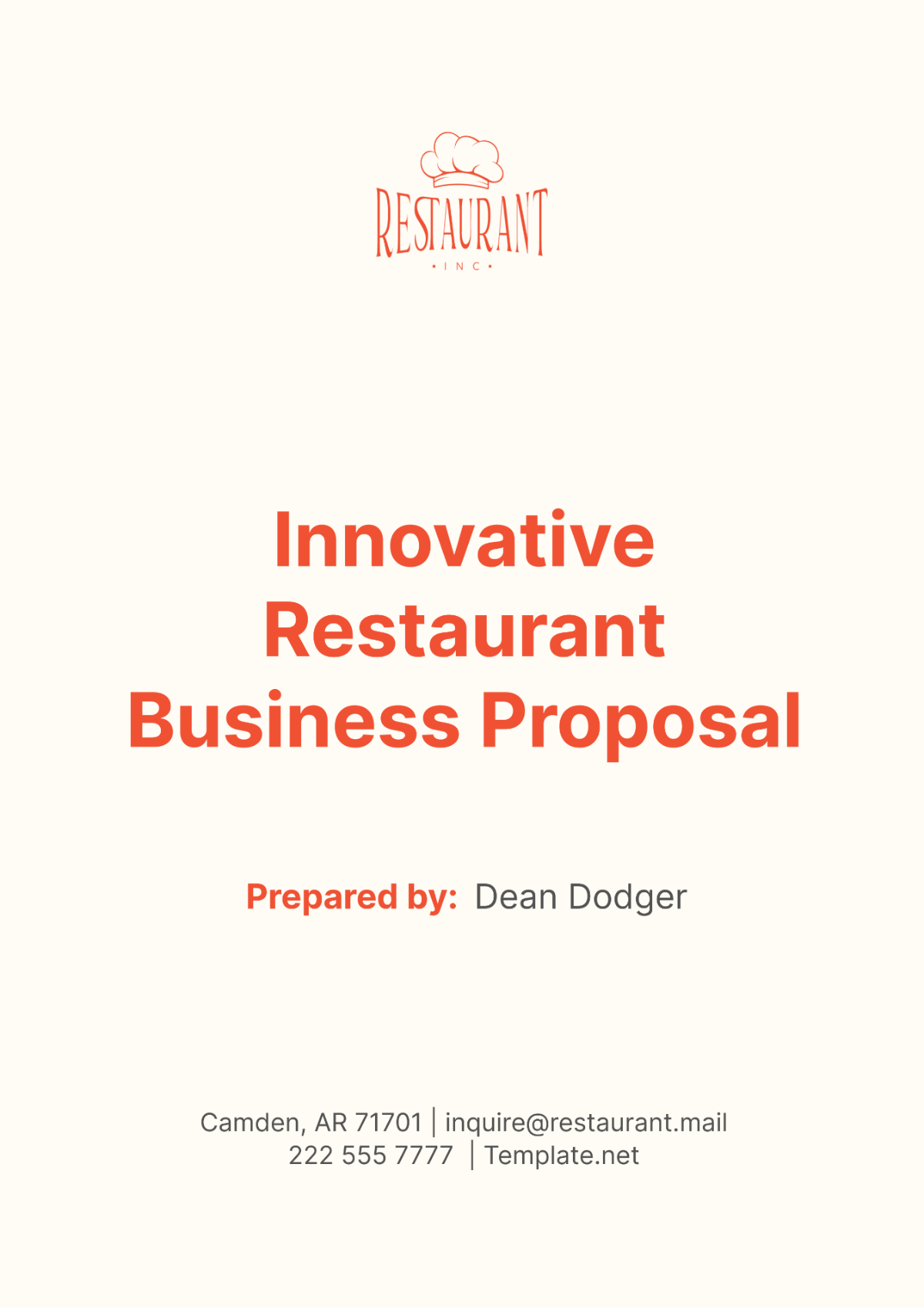
I. Executive Summary
The purpose of this proposal is to outline the innovative strategies and offerings proposed by [Your Company Name] to establish a cutting-edge restaurant that merges unique culinary techniques with immersive dining experiences. Our vision is to redefine the dining experience by integrating advanced technology and personalized service in a sustainable and environmentally friendly manner.
Our business proposal includes strategic goals, detailed project plans, cost breakdowns, and anticipated benefits. These elements are designed to secure investment and partnerships that will enable us to bring our innovative restaurant concept to life. We aim to create a dining environment that not only satisfies the palate but also engages the senses, offering a unique experience that goes beyond traditional dining.
The total budget for this project is estimated at $925,000. This investment will be allocated towards various aspects of the project, including the development of a culinary lab, the design and setup of the restaurant, recruitment and training of staff, creation of a dynamic menu, and a targeted marketing campaign. Each of these elements plays a crucial role in the successful execution of our innovative restaurant concept.
The timeline for this project spans from Q1 2050 to Q4 2050. During this period, we will focus on executing our project plans and deliverables, with the goal of launching our restaurant by the end of the year. This timeline ensures that we have sufficient time to meticulously plan and execute each phase of the project, thereby ensuring the successful launch of our innovative restaurant.
Ultimately, [Your Company Name] is set to transform the way people eat by introducing our groundbreaking restaurant concept. We invite you to join us on this exciting journey as we redefine dining and create a unique culinary experience for our customers.
II. Introduction
A. Overview
The restaurant industry is a dynamic and ever-evolving landscape. With the rise of technology and changing consumer preferences, it is crucial for businesses to stay ahead of the curve and offer unique and personalized dining experiences. [Your Company Name] is poised to do just that. Our vision is to redefine the dining experience through innovation in food preparation, personalized customer interaction, and sustainability practices. We aim to project ourselves as a leader in the future of the restaurant industry, setting new standards and trends.
Our mission is to create a dining environment that not only satisfies the palate but also engages the senses. We believe that dining is not just about food, but about the entire experience - from the ambiance and service to the presentation and taste of the food. By focusing on these aspects, we aim to create a memorable dining experience for our customers that will set us apart from the competition.
B. Objectives/Goals
Our objectives and goals are the guiding principles that will steer our business towards success. They are as follows:
Unique Dining Experience: Our primary goal is to establish a unique dining experience that combines traditional flavors with modern technology. We aim to create a fusion of taste and technology that will redefine dining.
Sustainable Business Model: We are committed to building a sustainable business model with a focus on environmental consciousness. We believe that businesses have a responsibility towards the environment and we aim to fulfill this responsibility through our practices.
Customizable Dining Experiences: We aim to offer customizable dining experiences tailored to individual dietary needs and preferences. We believe that every customer is unique and we aim to cater to these unique needs through our customizable menu options.
Market Share: We aim to achieve a 25% market share in the niche of innovative dining within two years. We believe that our unique offerings and superior service will enable us to capture a significant portion of the market.
Return on Investment (ROI): We aim to secure a Return on Investment (ROI) of at least 20% by the end of year three. We believe that our innovative business model and strategic planning will enable us to achieve this financial goal.
III. Problem and Solution
A. Problem Statement
The restaurant industry is a dynamic and complex landscape. It is characterized by intense competition, changing consumer preferences, and evolving trends. One of the key challenges that the industry faces today is the lack of differentiation and personalization options. In an era where consumers are increasingly seeking unique and personalized experiences, many restaurants often fall short in meeting these demands.
Additionally, with growing awareness and concern about environmental sustainability, there is a pressing need for sustainable practices within foodservice operations. These challenges present significant obstacles for businesses in the industry.
However, these challenges also present opportunities for innovation and differentiation. By addressing these issues head-on, businesses can not only meet the evolving demands of consumers but also set themselves apart from the competition.
B. Solution/Approach
At [Your Company Name], we believe in turning challenges into opportunities. Our approach to addressing the problems identified above is threefold:
Innovation in Cooking Techniques: We plan to introduce avant-garde cooking techniques like molecular gastronomy. This innovative approach to cooking will allow us to create unique and exciting dishes that not only taste great but also provide a visual spectacle for our customers.
Sustainable Practices: We are committed to creating a zero-waste dining environment. To achieve this, we will use biodegradable or reusable material for serving. This will not only help us reduce our environmental footprint but also resonate with environmentally conscious consumers.
Personalized Meals: We believe that every customer is unique and deserves a dining experience that reflects their individual preferences and dietary needs. To cater to this, we will offer personalized meals crafted through customer interaction and advanced technology. This will allow us to provide a truly personalized dining experience for each of our customers.
IV. Scope of Work or Deliverables
The success of our innovative restaurant hinges on a series of key deliverables that will be executed over the course of the project. These deliverables encompass various aspects of the restaurant setup, from the development of a culinary lab to the design of a marketing campaign.
A. Development of a Culinary Lab
The development of a fully operational culinary lab is a crucial first step in our project. This lab will serve as the heart of our restaurant, where our chefs will use avant-garde cooking techniques to create unique and exciting dishes. The lab will be equipped with the latest culinary technology, enabling us to push the boundaries of traditional cooking and offer our customers a dining experience like no other. The key tasks involved in this deliverable are:
Identifying and procuring the necessary culinary equipment.
Setting up the lab to facilitate efficient workflow.
Testing the equipment and ensuring it meets safety standards.
Training the staff on how to use the equipment.
Regular maintenance and updating of the equipment.
B. Design and Setup of the Restaurant
The design and setup of the restaurant are equally important. We aim to create an ambiance that is not only visually appealing but also incorporates smart technology to enhance the dining experience. From interactive menus to automated ordering systems, we will leverage technology to offer a seamless and personalized dining experience for our customers. The essential duties required for this deliverable include:
Developing a design concept that aligns with our brand.
Procuring the necessary furniture and decor items.
Setting up the restaurant layout for optimal customer flow.
Integrating smart technology into the restaurant setup.
C. Recruitment and Training of Staff
Our staff will play a pivotal role in delivering the unique dining experience we envision. We will recruit professionals with exceptional culinary and customer service skills and provide them with the necessary training to ensure they can deliver on our promise of a unique and personalized dining experience. The key tasks required are:
Identifying the staffing needs for the restaurant.
Recruiting skilled professionals who align with our brand values.
Providing comprehensive training on our unique culinary techniques.
Regular performance reviews and ongoing training.
D. Creation of a Dynamic Menu
The creation of a dynamic menu with customizable options is another key deliverable. We understand that each customer is unique, and we aim to cater to these unique needs through our menu. Whether it’s dietary restrictions or personal preferences, our menu will offer something for everyone. The primary tasks associated with this deliverable include:
Researching and identifying popular dietary preferences and restrictions.
Developing a range of dishes that cater to these preferences.
Regularly updating the menu based on customer feedback and food trends.
Training the staff on the menu items and their customization options.
Ensuring the menu aligns with our sustainability practices.
E. Marketing Campaign
Last but not least, we will design a marketing campaign targeted at early adopters of dining and technology. Through this campaign, we aim to create awareness about our unique offerings and attract customers who are always on the lookout for new and exciting dining experiences. The key tasks involved are:
Identifying our target audience and their preferences.
Developing a marketing strategy that resonates with this audience.
Creating engaging marketing content.
Leveraging various marketing channels to reach our audience.
Regularly reviewing and optimizing our marketing efforts based on performance metrics.
V. Timeline
The timeline for our project is a crucial component of our business proposal. It outlines the various phases of our project and provides a clear roadmap for the execution of our deliverables. The following table provides a detailed breakdown of our project timeline:
Phase | Q1 2050 | Q2 2050 | Q3 2050 | Q4 2050 |
|---|---|---|---|---|
Development and Planning | X | |||
Construction and Setup | X | X | ||
Staff Recruitment and Training | X | X | ||
Soft Opening | X | |||
Grand Opening | X |
A. Development and Planning
The ‘Development and Planning’ phase is the first step in our project. During this phase, we will focus on laying the groundwork for our restaurant. This includes developing our business plan, procuring the necessary equipment for our culinary lab, and designing the layout of our restaurant. This phase is crucial as it sets the foundation for the rest of our project.
B. Construction and Setup
The ‘Construction and Setup’ phase involves the actual establishment of the restaurant. During this phase, we will focus on constructing the physical structure of our restaurant and setting up the interior. This includes installing the necessary equipment in our culinary lab, setting up the dining area, and integrating smart technology into our restaurant setup.
C. Staff Recruitment and Training
The ‘Staff Recruitment and Training’ phase is where we build our team. We will recruit professionals with exceptional culinary and customer service skills and provide them with the necessary training. This phase is crucial as our staff will play a pivotal role in delivering the unique dining experience we envision.
D. Soft Opening
The ‘Soft Opening’ phase allows us to test our operations before the official launch. During this phase, we will invite a select group of customers to experience our restaurant. Their feedback will allow us to make necessary adjustments and improvements before the grand opening.
E. Grand Opening
The ‘Grand Opening’ phase marks the official launch of our restaurant. This is when we open our doors to the public and begin our journey in the restaurant industry.
Each phase of the project has its own significance and contributes to the overall success of the project. For instance, the ‘Development and Planning’ phase is crucial for laying the groundwork for the project, while the ‘Construction and Setup’ phase involves the actual establishment of the restaurant. The ‘Staff Recruitment and Training’ phase ensures that we have a team of skilled professionals ready to deliver exceptional service. The ‘Soft Opening’ allows us to test our operations and make necessary adjustments before the ‘Grand Opening’.
Moreover, this timeline is a strategic plan that ensures the smooth execution of our project. By following this timeline, we can ensure that each phase of the project is completed on time and that we are ready for the next phase. This systematic approach reduces the risk of delays and ensures that we are always on track to achieve our goals.
VI. Budget and Cost
The budget and cost for our project are critical components of our business proposal. They provide a detailed breakdown of the financial investment required for our project. The following chart and table provide the detailed breakdown of our project budget and cost. The chart focuses on the initial investment while the further details are provided in the table:
Item | Initial Investment | 2051 | 2052 | Total |
|---|---|---|---|---|
Setup and Design | $100,000 | $20,000 | $10,000 | $130,000 |
Culinary Lab | $200,000 | $50,000 | $20,000 | $270,000 |
Personnel and Training | $75,000 | $100,000 | $100,000 | $275,000 |
Marketing and Launch | $50,000 | $100,000 | $100,000 | $250,000 |
Total | $425,000 | $270,000 | $230,000 | $925,000 |
A. Setup and Design
The ‘Setup and Design’ costs cover the expenses related to the physical setup of the restaurant and its interior design. This includes the construction costs, the purchase of furniture and decor items, and the integration of smart technology into our restaurant setup. These costs are crucial as they ensure that our restaurant is not only functional but also visually appealing.
B. Culinary Lab
The ‘Culinary Lab’ costs are associated with the establishment of a state-of-the-art kitchen equipped with the latest culinary technology. This includes the purchase of equipment, the setup of the lab, and the maintenance and updating of the equipment. These costs are crucial as they enable us to offer a unique and exciting dining experience.
C. Personnel and Training
The ‘Personnel and Training’ costs ensure that we have a team of well-trained professionals to deliver exceptional service. This includes the recruitment costs, the training costs, and the salaries and benefits for our staff. These costs are crucial as our staff play a pivotal role in delivering the unique dining experience we envision.
D. Marketing and Launch
The ‘Marketing and Launch’ costs are allocated for promoting the restaurant and ensuring a successful launch. This includes the costs associated with developing a marketing strategy, creating marketing content, and leveraging various marketing channels to reach our target audience. These costs are crucial as they help us create awareness about our unique offerings and attract customers.
Each item in the budget plays a significant role in the project. For example, the ‘Setup and Design’ costs ensure that our restaurant is visually appealing and functional, while the ‘Culinary Lab’ costs enable us to offer a unique dining experience. The ‘Personnel and Training’ costs ensure that we have a team of skilled professionals, and the ‘Marketing and Launch’ costs help us attract customers.
Moreover, the budget is not just a financial plan; it is a strategic tool that helps us allocate our resources effectively. By carefully planning and managing our budget, we can ensure that we have the necessary funds to execute each phase of our project and achieve our goals. This financial planning is crucial for the success of our project and the sustainability of our business.
VII. Benefits and Value Proposition
[Your Company Name] offers an evolution in the dining experience, creating a strong value proposition by seamlessly integrating innovation in food science with sustainable practices and hyper-personalized services. Our unique offerings provide a range of benefits for our customers, our business, and the environment.
A. Customer Benefits
Unique Dining Experience: Our customers will enjoy a unique dining experience that combines traditional flavors with modern technology. This fusion of taste and technology will redefine dining and offer a truly unique experience.
Personalized Meals: Our customers will have the opportunity to enjoy meals that are tailored to their individual dietary needs and preferences. This personalization will ensure that every meal is not only delicious but also perfectly suited to their tastes and dietary requirements.
Sustainable Practices: Our customers will appreciate our commitment to sustainability and our efforts to create a zero-waste dining environment. This commitment to sustainability will not only reduce our environmental impact but also resonate with our environmentally conscious customers.
Engaging Atmosphere: Our customers will enjoy dining in an ambiance that is visually appealing and incorporates smart technology. This engaging atmosphere will enhance the dining experience and make every meal a memorable one.
Exceptional Service: Our customers will receive exceptional service from our team of professionals who are trained in culinary skills and customer service. This exceptional service will ensure that every customer feels valued and taken care of.
B. Business Benefits
Differentiation: Our unique offerings will set us apart from the competition and give us a competitive edge in the market. This differentiation will make us a preferred choice for customers looking for a unique dining experience.
Customer Loyalty: By offering a unique and personalized dining experience, we can build customer loyalty and encourage repeat business. This customer loyalty will contribute to our long-term success and growth.
Brand Image: Our commitment to innovation and sustainability will enhance our brand image and make us a preferred choice for customers. This positive brand image will attract more customers and contribute to our market share.
Market Share: By catering to the evolving demands of customers, we can capture a significant market share in the niche of innovative dining. This market share will contribute to our profitability and long-term success.
C. Environmental Benefits
Reduced Waste: By using biodegradable or reusable material for serving, we can significantly reduce the waste generated by our restaurant. This reduction in waste will contribute to environmental conservation and sustainability.
Sustainable Sourcing: We will source our ingredients from local farmers and suppliers who practice sustainable farming, thereby reducing our carbon footprint. This sustainable sourcing will contribute to local economies and promote sustainable farming practices.
Energy Efficiency: We will use energy-efficient appliances in our culinary lab and restaurant, thereby reducing our energy consumption. This energy efficiency will not only reduce our operating costs but also contribute to environmental conservation.
Conservation of Resources: By minimizing waste and optimizing resource usage, we contribute to the conservation of natural resources. This conservation of resources will ensure the sustainability of our operations and contribute to environmental conservation.
Promotion of Sustainable Practices: By demonstrating successful implementation of sustainable practices, we can inspire other businesses to follow suit and contribute to a more sustainable future. This promotion of sustainable practices will have a broader impact on the industry and society as a whole.
VIII. Risk Assessment
Every business venture comes with its own set of risks and challenges. In the restaurant industry, these risks can range from operational to financial. It’s crucial to identify these risks early on and develop strategies to mitigate them.
A. Technological Challenges
Adopting New Technologies: As we plan to integrate advanced technology into our restaurant operations, one of the potential challenges could be the swift adoption of these new technologies. This includes training our staff to use these technologies and ensuring they are comfortable with them. To mitigate this, we will provide comprehensive training and support to our staff to ensure a smooth transition.
Maintaining Technological Infrastructure: Maintaining the technological infrastructure could also pose a challenge. This includes regular updates, dealing with technical glitches, and ensuring seamless operation. Regular maintenance and having a dedicated IT support team can help address this challenge.
Cybersecurity Risks: With the use of technology, comes the risk of cyber threats. Protecting our digital assets and customer data will be of utmost importance. Implementing robust cybersecurity measures and regular audits can help mitigate this risk.
Technological Obsolescence: Technology evolves rapidly. There’s a risk that the technology we adopt today may become obsolete tomorrow. Staying updated with the latest technological trends and being open to adopting new technologies can help mitigate this risk.
Dependence on Technology: While technology can streamline operations, over-reliance on it could lead to operational challenges if there are technical issues or outages. Having contingency plans in place and training staff to handle such situations can help address this risk.
B. Market Risks
Customer Reception: As we plan to introduce a new dining format, there’s a risk that it may not be well received by all customers. Conducting market research and gathering customer feedback can help mitigate this risk.
Competition: The restaurant industry is highly competitive. There’s a risk that competitors may also start offering similar experiences or lower their prices to attract customers. Differentiating our offerings and providing exceptional customer service can help us stand out in the competition.
Changing Consumer Preferences: Consumer preferences can change rapidly. There’s a risk that the preferences we are catering to today may not be relevant tomorrow. Regularly updating our menu based on customer feedback and staying abreast of food trends can help us stay relevant.
Economic Factors: Economic factors such as inflation, recession, or changes in disposable income can impact the restaurant industry. Regular financial forecasting and having a flexible business model can help us navigate these economic fluctuations.
C. Financial Risks
Higher Initial Costs: As our restaurant concept involves the use of advanced technology and sustainable practices, the initial setup cost could be higher than traditional restaurants. Careful budgeting and financial planning can help manage these costs.
Return on Investment: There’s a risk that we may not be able to achieve the projected return on investment within the expected timeframe. Regular financial reviews and performance tracking can help us stay on track.
Cash Flow Management: Managing cash flow effectively will be crucial, especially in the initial stages when the expenses are high. Regular cash flow forecasting and maintaining a cash reserve can help manage cash flow effectively.
Unexpected Expenses: There could be unexpected expenses that come up during the setup or operation of the restaurant. Having a contingency fund can help manage these unexpected expenses.
Fluctuations in Food Prices: The cost of ingredients can fluctuate due to various factors such as seasonal changes, supply chain issues, or changes in import/export regulations. This could impact our food costs and profit margins. Regularly reviewing our supply chain and having multiple suppliers can help manage these fluctuations.
D. Regulatory Risks
Food Safety Regulations: Compliance with food safety regulations will be crucial. Non-compliance could lead to penalties or even closure of the restaurant. Regular audits and staff training on food safety can help ensure compliance.
Employment Laws: We will need to comply with employment laws, including minimum wage laws, overtime laws, and health and safety regulations. Regular legal reviews and staff training can help ensure compliance.
Liquor Licensing: If we plan to serve alcohol, we will need to obtain a liquor license and comply with all related regulations. Hiring a legal expert can help navigate the licensing process.
Health and Safety Regulations: Compliance with health and safety regulations will be crucial to ensure the safety of our customers and staff. Regular safety audits and staff training can help ensure compliance.
Environmental Regulations: As we plan to implement sustainable practices, we will need to ensure compliance with environmental regulations. Regular environmental audits can help ensure compliance.
Changes in Regulations: Regulations can change over time. Keeping up-to-date with the latest regulations and ensuring compliance will be crucial. Regular legal reviews can help stay updated with regulatory changes.
IX. Conclusion and Call to Action
In conclusion, [Your Company Name] is poised to revolutionize the dining experience through our innovative restaurant concept. We believe that our unique blend of culinary innovation, personalized service, and sustainable practices will set us apart in the restaurant industry and provide a unique value proposition for our customers.
Our business proposal outlines a clear path to achieving this vision. From the development of a state-of-the-art culinary lab to the design of a targeted marketing campaign, each aspect of our project has been meticulously planned to ensure the successful execution of our innovative restaurant concept.
We invite you to seize this opportunity to invest in the future of dining. Your investment will not only contribute to the success of our restaurant but also the evolution of the dining experience as a whole. Together, we can transform the culinary landscape and offer an unmatched dining experience.
For further details or to schedule a meeting, please contact us at [Your Company Email] or [Your Company Number]. We look forward to embarking on this exciting journey with you. Let’s redefine the dining experience together!
- 100% Customizable, free editor
- Access 1 Million+ Templates, photo’s & graphics
- Download or share as a template
- Click and replace photos, graphics, text, backgrounds
- Resize, crop, AI write & more
- Access advanced editor
Present innovative business proposals with the Innovative Restaurant Business Proposal Template only on Template.net! This editable solution helps to outline unique business concepts and strategies. Customize the proposal using its customizable features to showcase your restaurant's innovative ideas and value propositions. Easily generate your proposal with the AI Editor Tool!
You may also like
- Business Proposal
- Research Proposal
- Proposal Request
- Project Proposal
- Grant Proposal
- Photography Proposal
- Job Proposal
- Budget Proposal
- Marketing Proposal
- Branding Proposal
- Advertising Proposal
- Sales Proposal
- Startup Proposal
- Event Proposal
- Creative Proposal
- Restaurant Proposal
- Blank Proposal
- One Page Proposal
- Proposal Report
- IT Proposal
- Non Profit Proposal
- Training Proposal
- Construction Proposal
- School Proposal
- Cleaning Proposal
- Contract Proposal
- HR Proposal
- Travel Agency Proposal
- Small Business Proposal
- Investment Proposal
- Bid Proposal
- Retail Business Proposal
- Sponsorship Proposal
- Academic Proposal
- Partnership Proposal
- Work Proposal
- Agency Proposal
- University Proposal
- Accounting Proposal
- Real Estate Proposal
- Hotel Proposal
- Product Proposal
- Advertising Agency Proposal
- Development Proposal
- Loan Proposal
- Website Proposal
- Nursing Home Proposal
- Financial Proposal
- Salon Proposal
- Freelancer Proposal
- Funding Proposal
- Work from Home Proposal
- Company Proposal
- Consulting Proposal
- Educational Proposal
- Construction Bid Proposal
- Interior Design Proposal
- New Product Proposal
- Sports Proposal
- Corporate Proposal
- Food Proposal
- Property Proposal
- Maintenance Proposal
- Purchase Proposal
- Rental Proposal
- Recruitment Proposal
- Social Media Proposal
- Travel Proposal
- Trip Proposal
- Software Proposal
- Conference Proposal
- Graphic Design Proposal
- Law Firm Proposal
- Medical Proposal
- Music Proposal
- Pricing Proposal
- SEO Proposal
- Strategy Proposal
- Technical Proposal
- Coaching Proposal
- Ecommerce Proposal
- Fundraising Proposal
- Landscaping Proposal
- Charity Proposal
- Contractor Proposal
- Exhibition Proposal
- Art Proposal
- Mobile Proposal
- Equipment Proposal
- Student Proposal
- Engineering Proposal
- Business Proposal

